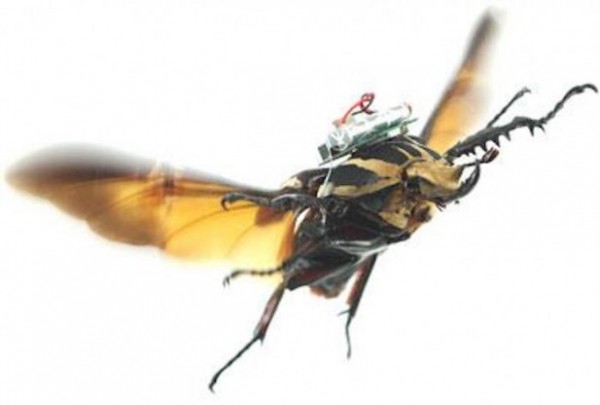Cyborg Beetles Unravel the Mechanism of Flying Insects
| Marco Foronda | | Mar 17, 2015 11:20 AM EDT |
(Photo : Tat Thang Vo Doan and Hirotaka Sato/NTU Singapore) A giant flower beetle is shown flying with an electronic backpack. Researchers remotely control its untethered flight by stimulating a newly discovered steering muscle.
Beetles are now being controlled by scientists. They're called "cyborg beetles."
Scientists are using radio transmitters and mini electronics backpacks attached to the backs of giant flower beetles to control these insects in flight.
Scientists said they can learn a lot about the biology of beetles by using this invention. University of California, Berkeley and Singapore's Nanyang Technological University (NTU) engineers led the cyborg beetle research and are continuously looking for new insights into how these cyborgs behave.
Like Us on Facebook
Every action of the beetles like taking off and landing; flying to the right or left or even hovering in mid-flight depends on radio commands, according to the scientists.
Researchers said the electronics used for the movements of insects have been used before but it's believed this is the first scientific demonstration using radio commands to control the fine aerial movements of flying beetles.
"Beetles are ideal study subjects because they can carry relatively heavy payloads," said Hirotaka Sato of the Nanyang Technological University in Singapore.
"We could easily add a small microphone and thermal sensors for applications in search-and-rescue missions. With this technology, we could safely explore areas not accessible before, such as the small nooks and crevices in a collapsed building".
The study discusses the significant involvement of tiny microprocessors and the built-in wireless receivers along with transmitters placed on the giant flower beetles. The device is powered by a 3.9 volt lithium battery and is connected to six micro-electrodes implanted into the insect's wing-folding coleopteran muscles.
The demonstration shows that tiny electrodes are the answer to controlling these insects.
The new study was published in the journal, Current Biology.
TagsCyborg Beetle Unravel the Mechanism of Flying Insects, cyborg beetle, beetle, Insects, microprocessor, insect transmitter
©2015 Chinatopix All rights reserved. Do not reproduce without permission
EDITOR'S PICKS
-

Did the Trump administration just announce plans for a trade war with ‘hostile’ China and Russia?
-

US Senate passes Taiwan travel bill slammed by China
-

As Yan Sihong’s family grieves, here are other Chinese students who went missing abroad. Some have never been found
-

Beijing blasts Western critics who ‘smear China’ with the term sharp power
-

China Envoy Seeks to Defuse Tensions With U.S. as a Trade War Brews
-

Singapore's Deputy PM Provides Bitcoin Vote of Confidence Amid China's Blanket Bans
-

China warns investors over risks in overseas virtual currency trading
-

Chinese government most trustworthy: survey
-

Kashima Antlers On Course For Back-To-Back Titles
MOST POPULAR
LATEST NEWS
Zhou Yongkang: China's Former Security Chief Sentenced to Life in Prison

China's former Chief of the Ministry of Public Security, Zhou Yongkang, has been given a life sentence after he was found guilty of abusing his office, bribery and deliberately ... Full Article
TRENDING STORY

China Pork Prices Expected to Stabilize As The Supplies Recover

Elephone P9000 Smartphone is now on Sale on Amazon India

There's a Big Chance Cliffhangers Won't Still Be Resolved When Grey's Anatomy Season 13 Returns

Supreme Court Ruled on Samsung vs Apple Dispute for Patent Infringement

Microsoft Surface Pro 5 Rumors and Release Date: What is the Latest?










